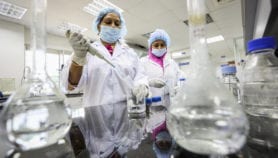Send to a friend
The details you provide on this page will not be used to send unsolicited email, and will not be sold to a 3rd party. See privacy policy.
GM production is up, but that doesn’t mean Latin Americans like or want it, say Luisa Massarani, Ildeu de Castro Moreira and Ana Maria Vara*.
A report launched by the International Service for the Acquisition of Agri-Biotech Applications (ISAAA) in March 2010 paints a rosy picture of small-scale farmers embracing — and benefitting from — genetic modification (GM) technology at a rapid pace (see GM crops flourishing in developing world, says report).
But recent research from China shows that wide planting of GM cotton has caused a surge in pests (see Bt cotton linked with surge in crop pest).
Our experience in Brazil and Argentina — both among the world’s top producers of GM crops — similarly indicates that growth in GM crop production has guaranteed neither wide-scale social acceptance of the technology nor benefits for small-scale farmers.
Early acclaim
It is true that when, in the late 1990s, international agribusiness Monsanto introduced Argentina to Roundup Ready soya (a crop designed to tolerate the herbicide glyphosate), politicians and many commercialfarmers welcomed it with open arms.
Very early on, multinational corporations and farmers’ associations began an intense promotional campaign for GM crops, trading on the country’s view of itself as a leading grain producer.
Just one government office was responsible for GM crops, and this helped ensure the legal system didn’t pose any obstacles. In fact, the issue of GM food was never really put up for public debate.
And Monsanto’s GM soya arrived in Argentina when the country was entering a major economic crisis, and agricultural income was badly needed.
There were other favourable economic factors too. Monsanto didn’t have a monopoly over the technology because it could not patent its Roundup Ready soya in Argentina. Also, glyphosate was no longer under patent; field machinery was easily accessible under contract; and to GM needed less field labour compared with non-GM soya.
Perhaps most importantly, GM soya was highly profitable, especially when combined with non-till practices and an increase in agro-chemical use. All these factors contributed GM soya’s rapid penetration into Argentinean agriculture.
But our interviews and focus groups with about 50 Argentinean small-scale farmers in 2007revealed concern about the social changes the switch to GM soya causes. GM profits for many came not from growing the crop themselves, but from renting their land to commercial farmers for large-scale production.
This threatens sustainability because it increases small-scale farmers’ reliance on external parties for their income, and can also mean both agricultural skills and land fertility are lost.
Battle for Brazil
In Brazil, the opposition to GM crops has been much more overt, with Monsanto’s move to introduce Roundup Ready soya sparking almost a decade of controversies and legal disputes.
As early as 1998the Worker’s Party — the main opposition party at the time— adopted an anti-GM stance. Some state governments too, for example in Rio Grande do Sul and Paraná, ideologically opposed GM crops and even implemented local legislation to prohibit them.
Environmental groupsand social movements, such as Greenpeace and the Movement of the Landless Rural Workers, also took up anti-GM positions and were much more vocal and active in campaigning against GM crops than their Argentinean counterparts.
And if political divisions have characterised the GM debate in Brazil, so too have divisions within the scientific community.
The community generally supported research into GM crops. The Brazilian Academy of Science also supported growing them. But several prominent scientists, including Glaci Zancan, then president of the Brazilian Association for the Advancement of Science, opposed commercial GM crops in the absence of long-term studies on health and environmental impacts.
Overcoming opposition
Despite the controversy and criticism, GM crop cultivation has expanded rapidly in Brazil, even before it was legally approved in 2005. Our focus groups and individual interviews with about 80 Brazilian stakeholders and approximately 200 small-scale farmers reveal many reasons for this growth.
They include the use of non-approved GM seeds illegally brought over from Argentina; a curiosity for testing new seeds; pressures to keep the harvest as economically productive as possible; and the fact that, in some regions, conventional soya seeds are becoming hard to find.
But more important than these factors has been the clever tactics employed by the pro-GM lobby, which even include — according to some of our interviewees — doling out free GM seeds.
The most significant move was the tactic that got GM soya legalised in 2005. The pro-GM lobby got the issue of stem cell research onto the same bill as GM soya — the biosafety law. This move capitalised on the much broader support among politicians, scientists and the public for stem cell research.
The strategy worked — the bill was passed by parliament by 352 votes to 60, and officially enabled the production and sale of GM soya in Brazil.
But the debate is far from over. There are still strong tensions around GM within government, and small-scale farmers remain unconvinced. Our research found a strong demand for unbiased information on GM crops and three national surveys also found a lack of acceptance of GM crops, even among farmers growing GM soya. Indeed, a common refrain among those we interviewed was "I’m happy to grow it, but I wouldn’t eat it".
In Latin America, as in many developing regions of the world, the GM debate is ‘messy’. There is a danger in interpreting a simple increase in GM crop cultivation as a sign that countries are wholeheartedly in favour of the technology, or that acceptance and benefits are widespread.
Luisa Massarani is Latin America and Caribbean coordinator for SciDev.Net and researcher at Museum of Life, House of Oswaldo Cruz, Fiocruz, Brazil.
Ildeu de Castro Moreira is a professor at the Federal University of Rio de Janeiro, Brazil.
Ana Maria Vara is a researcher at the National University of San Martín, Argentina.
*The authors thank Carla Almeida and Fabio Gouveia for their contributions to both this article and the research project it mentions, which was supported by the International Development Research Centre.
See Letter to the editor.













